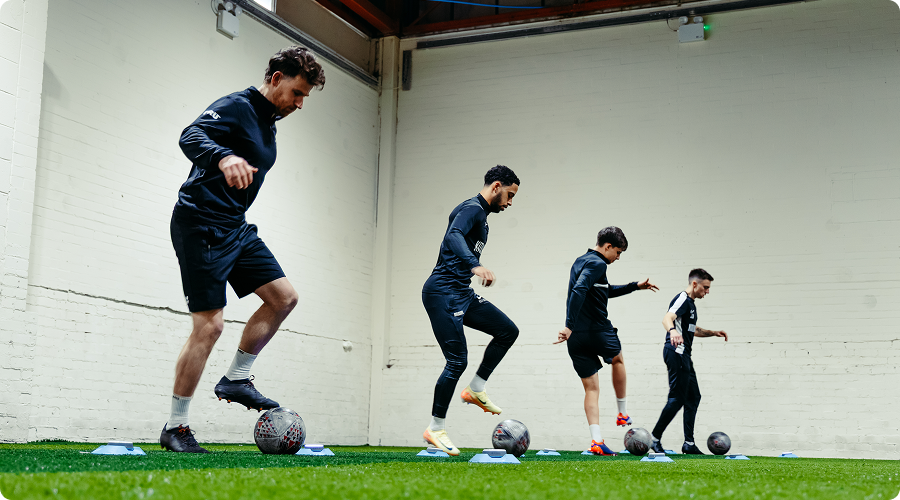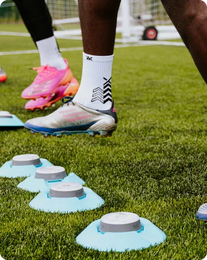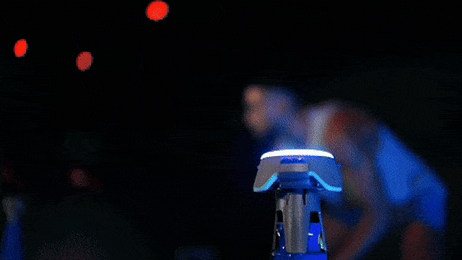You don’t need a pitch, cones, or teammates to sharpen your touch. In fact, some of the best training happens at home - in your backyard, your garage, or even your living room.
Whether you're trying to get more touches on the ball, build faster reactions, or just stay consistent between sessions, home soccer training gives you the flexibility to work on your game anywhere. The key? Focused, intentional drills that challenge your body and your brain.

Here’s what we’ll cover:
-
What makes home soccer training effective
-
How to train without a full-size pitch or fancy equipment
-
The best drills to build control, decision-making, and quick reactions
-
How to stay motivated when you’re training solo
Let’s break down how to make real progress - right where you are.
Why Home Soccer Training Works
Training from home is about getting more out of your time, space, and focus.
What You Can Improve at Home
-
Ball control: The foundation of your game. Tight spaces are ideal for working on close touches.
-
Footwork and agility: Indoors or outdoors, drills that demand speed and sharp directional changes keep your feet fast.
-
Reaction time: Improve your decision-making speed with cognitive drills that mimic match-day chaos.
-
Consistency: Training at home—alongside your team sessions—is where real progress happens. Solo drills keep you focused on specific goals and build the daily habits that set top players apart.
With or without equipment, every rep counts.
Set Yourself Up to Win
You don’t need much to get started. Grab a ball, clear some space, and if you have tools like BlazePod, even better. But no matter what, the key is intentional movement with focus.
Let’s get into the drills.
Solo Soccer Drills for Small Spaces
Home Soccer Drills You Can Start Today
These drills are built for limited space, quick setup, and big impact. Whether you’re training in your bedroom, hallway, or driveway, these exercises sharpen your skills and keep your brain in the game.
-
Focus Ball Control
This drill is perfect for players looking to sharpen their footwork, ball control, and quick decision-making.
To set it up, place four Pods - or substitute objects - in a straight line on the ground, about 50cm apart. Begin with the ball at your feet, standing in front of the first Pod. When a Pod lights up (or when you’ve assigned it a number to follow), swiftly move the ball in front of the lit Pod while keeping your body facing forward. Navigate the ball around the Pod, then progress to the next one that lights up. Repeat this sequence for the full duration of the drill.
This exercise is ideal for solo soccer drills at home, especially in small indoor spaces, and helps develop coordination, peripheral awareness, and close ball control.
-
Ball Control Drill
This drill focuses on improving control under pressure, scanning, and movement in compact areas.
Start by placing four Pods in a row on the ground, spaced 30cm apart. Position yourself with the ball roughly 20cm away from the line of Pods. As one Pod lights up, maneuver the ball to the opposite side of that Pod. Push the ball around the lit Pod with complete control, moving it front to back, and then quickly look up to identify the next cue. It’s important to maintain balance and avoid reaching or lunging for the ball.
This type of home soccer training reinforces ball control and vision while introducing low-level cognitive stress that mimics real match-day pressure.
-
Lateral Double Hurdle Drill
Designed to improve agility, lateral speed, and quick changes in direction, this drill uses minimal equipment and can be performed in a tight space.
Arrange four Pods with two small hurdles in the middle - books or rolled towels will work just fine. Start on one side of the hurdles. As a Pod lights up, move laterally over the hurdle to tap it. If the Pod on the same side lights up again, return over the hurdle and tap it once more. Repeat the pattern, focusing on fast footwork and maintaining control.
It’s a brilliant example of soccer exercises that push your reaction time, coordination, and explosiveness in just a few square meters.
-
Dribble and Pass Drill
This drill targets passing accuracy, close ball control, and scanning while in motion.
To set it up, place a rebounder or wall target approximately 5 meters away. Then, line up three Pods (or markers) on the ground in a row, spaced 2 meters apart. Start with the ball at your feet, positioned between the Pods and the rebounder. When one of the Pods lights up, dribble around it within 2.5 seconds. Then pass the ball against the rebounder and tap the home base Pod. Receive the ball, turn, and repeat the sequence.
This is a great option for indoor soccer practice, particularly in a garage, hallway, or backyard. It builds muscle memory for clean turns, improves passing under pressure, and encourages constant scanning - so always check your shoulder before the turn.
Keep It Consistent
How to Stay Motivated When Training Solo
Solo training can be tough - but it’s where growth happens. Here’s how to stay consistent:
-
Set micro-goals for each session (e.g. 30 clean touches in 30 seconds)
-
Time your drills and try to beat your previous best
-
Add light competition: record your drills and challenge friends
-
Create a simple weekly routine (2–3 drills, 20 minutes a day)
You’ll see gains faster than you think.
So... How Do You Train Soccer at Home?
The answer:
-
Pick tight-space drills that work your control, agility, and reaction
-
Train consistently, even for just 15–20 minutes
-
Create challenges that force you to stay engaged and improve
And if you want to take it up a level? Add a tool like BlazePod to introduce cognitive pressure, custom drills, and real-time feedback that accelerates your progress.
Because the best players don’t wait for the perfect session - they build it.






















